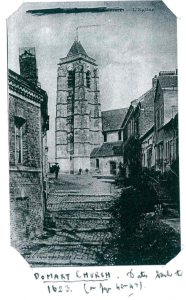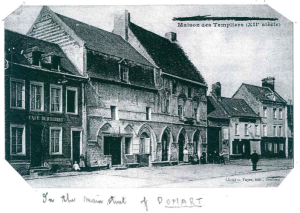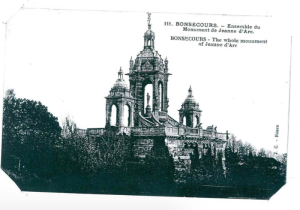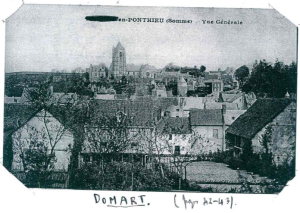Monthly Archives: July 2016
6th July 1916 Thursday
All material produced or reproduced here and throughout this work is the sole copyright of the author and the family of Doctor D.C.M. Page MC.
“July 6th was spent in tidying up our hospital and attending to our wounded brought down during the day. In the evening some of us took a motor ambulance and went forward to view the ‘Battle Area’. We made our way through several villages which were crammed with our guns of all shapes and sizes. They were all blazing away at the Huns and the sight from the top of the last ridge was awe inspiring. We could see the shells bursting all along the German positions. Their retaliations seemed to be very feeble.”
Find out about our connection with Dr Page and an introduction to his diary here
5th July 1916 Wednesday
All material produced or reproduced here and throughout this work is the sole copyright of the author and the family of Doctor D.C.M. Page MC.
“At 6pm on July 5th, a beautiful warm and sunny day, Lt. Buckly and I moved off with the stretcher bearers. We marched via Mericourt and Treux to Morlancourt. Many troops passed us on the way back from Monday’s great battle. All were very tired and dusty but full of beans. Many carried German helmets, caps and other souvenirs. We passed the Gordons and the 8th Devons. The whole countryside was seething with troops. We also saw a large number of German prisoners, our first glimpse of the enemy. They were all very tired and dirty and woebegone. Although they were very lucky to be where they were and out of the war now for good.
Morlancourt was a dirty little village full of troops. We were supposed to relieve the 23rd Field Ambulance (7th Division), but they had no orders to move. So we spent the night in tents in a field close to the hospital, which was in a dilapidated church. We saw a German Major being brought down under arrest. He had surrendered on Monday and when being brought back threw a bomb at some of our men, which he had concealed under his cap, killing three and wounding seven of them. I don’t know why he wasn’t shot on the spot! Our Division (38th) relieved the 7th Division at night.”
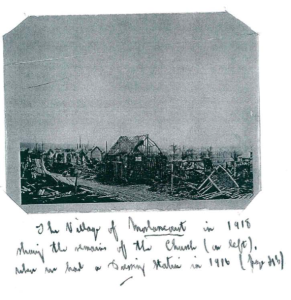
“The Village of Morlancourt in 1918 showing the remains of the church (on left) where we had a Dressing Station in 1916”
Find out about our connection with Dr Page and an introduction to his diary here
4th July 1916 Tuesday
All material produced or reproduced here and throughout this work is the sole copyright of the author and the family of Doctor D.C.M. Page MC.
“We didn’t get settled into our barns at Franvillers until 3.30 on July 4th. We lounged about all that day and got ready for another forward march. We saw a lot of cavalry (11th Hussars) going back and transport of Battalions that had been wiped out. It was reported that the progress of the Battalions was satisfactory – that was all the news we got.
At 10pm we marched off again with the Brigade to Heilly – 3 miles distant. We were billeted in canvas huts and had to plunge and wallow through lovely sticky mud to get to them. A terrific bombardment went on all night- the very ground shook with it. None of us slept much.”
Are you a new reader?
Find out about our connection with Dr Page and an introduction to his diary here
3rd July 1916 Monday
All material produced or reproduced here and throughout this work is the sole copyright of the author and the family of Doctor D.C.M. Page MC.
A hundred years on and the weather on the Somme was remarkably similar to that which we have been experiencing now in London. Changeable, either glorious or cold and wet.
By the third day of the battle the realities and horror of it all began to manifest as Douglas’s workload grew to unworkable proportions.
“Next day July 3rd– We were back again at the C.C.S. All the wounds we dressed were sceptic as the men had lain so long in the open without being able to receive attention. They were in a pitiful plight. The first man I attended to had his nose and mouth shot away and his hand and both his legs severely shattered necessitating amputation.
At 8pm we left for Franvillers. It was a long wearisome march in the dark and the rain came down in buckets. At one crossroad we had to wait about an hour whilst two miles of artillery passed by along the main road.”
Are you a new reader?
Find out about our connection with Dr Page and an introduction to his diary here
2nd July 1916 Sunday
All material produced or reproduced here and throughout this work is the sole copyright of the author and the family of Doctor D.C.M. Page MC.
On the second day, Douglas and his team start to get the true picture of what was unfolding at the front as the casualties began to roll in.
“On July 2nd, we all went to the C.C.S. to help the staff there to cope with the never ending stream of wounded. A large string of ambulances, ammunition lorries, waggons, full of wounded right through the village was slowly coming into the hospital. I got to work in a hut amongst the walking wounded cases, most of the wounds were caused by machine gun bullets and the poor men although very cheery, were dead tired and full of dust and mud. Most of them were wounded in more than one place. Many different regiments were represented: Royal Scots, Tyneside Scots, H.L.I. (Highland Light Infantry), Borderers, Lincolns , Lancs and Yorks, and &c.
There were four of us and a nursing sister working together in this hut and we attended to hundreds of cases. It was a large hospital in marquees, tents and huts and a battalion of H.L.I. acted as stretcher bearers. Only fifteen cases died during the day. All day hospital trains were evacuating wounded from a siding close by. Most of the wounded had laid out in the open for fourteen hours before being picked up and removed by stretcher bearers.
All the men were confident that the German’s casualties were much heavier than ours. One of the 15th Royal Scots told me that the Battalion had been practically wiped out. We left off work at about 9pm after six hours unceasing toil but we were glad that we could help.”
Are you a new reader?
Find out about our connection with Dr Page and an introduction to his diary here
27th June 1916 to 1st July 1916 – Somme Special
All material produced or reproduced here and throughout this work is the sole copyright of the author and the family of Doctor D.C.M. Page MC.
Master’s in the trenches with his only son;
Mistress manages the farm and keeps a poultry run;
Miss Belinda roasts and bakes and answers all the bells,
For Cook and House-and Kitchen-maid are all making shells.
http://www.gutenberg.org/files/38944/38944-h/38944-h.htm
June 27th 1916 Tuesday
Douglas made his way back with his kit and joined the throng of civilians, completely outnumbered by the mass of military men waiting to board the afternoon train from Waverley station. Soldiers of all ranks and Royal Navy men, shoved and pushed their way along the platform, many hugging tearful loved ones, many for the very last time, before the heavy train slowly hauled its way out of the station.
“I left Edinburgh at 2.30pm on June 27th arriving at Kings Cross about midnight. Crowded, uncomfortable train. I spent the night at the *Alexandra Pavilion in Victoria and was very comfortable. This was run by the Y.M.C.A and the people in charge were most hospitable.”
*An update on the Alexandra Pavilion will follow.
June 28th 1916 Wednesday
Douglas made his way to the station and described the scene at Victoria. This was a scene that was happening at the other London stations that served the south coast at the same time as hundreds upon hundreds of troops made their way to the Western Front for “The Big Push”. Wives, sisters, sweethearts, parents and friends made the station forecourts and platforms enormously crowded places with the noise of shouting and crying. Mothers shrieking as their sons boarded the trains.
Destinations were announced at the last minute then the people would rush to the platforms. The noise would have been deafening. The sulphury atmosphere and the rising steam from the locomotives, the shouting of railway staff. Then the sudden fright as a locomotive blew off its safety valves with the deafening hiss of escaping steam. The iron clad tyres of carts clattering across the cobbled forecourts bringing supplies in for the trains. Motor lorries and ambulances queuing to bring returning injured men out. Then of course the orderly queue of Hansom Cabs in the cab road with officers clambering down to join the men.
“Left Victoria Station at 8.30 on June 28th – packed train. Huge crowds at the station and many affecting sights as the last farewells were said. It was most distressing and I felt very mouldy as the train sped through England. Three crowded boats left Folkestone at 11.15am. Fine trip across arriving at Boulogne about 12.30pm. I entrained at about 1.15pm for Abbeville.
This was a painfully slow trip, but I had the company of some Welsh officers. At Abbeville we had a good tea at the Hotel de la Fete de Boufe and got into another train at about 8pm.”
June 29th 1916 Thursday
“We were in the train all night without food and felt pretty miserable when we were eventually dumped at Candes at 10.00 am. We started trekking towards Bernville, where Divisional Headquarters was supposed to be, but luckily one of our motor ambulances came along and gave us a lift towards St. Hilaire. There I found the 130th (St. John) Field Ambulance and was warmly welcomed by all. St Hilaire was a tiny hamlet in lovely country. Close by was Domart, a beautiful village……, here we discovered a beautiful old church dated 1623.”
June 30th 1916 Friday
“On June 30th we left St. Hilaire at 4pm and marched in the centre of 114th Brigade column via Bernvil and Talmas to Maison, a large farm where we spent the night. We all slept together in a huge barn and were very comfortable. The day was very warm and sunny and it was a grand sight to see the seemingly endless column of men, nurses and wagons slowly moving along.”
July 1st 1916 Saturday
On returning to France after being allowed leave home, too late for his father’s funeral only three weeks before, Douglas re-joins his men. The preparations for the “Big Push” had been in the making for six months and though Douglas never mentions it in the previous days, it’s hard to imagine that he wasn’t fully aware that it was about to take place.
After all, due to the carelessness of British preparations, the Germans knew all they needed to know two and a half months before the start. Not only had they been listening in to British un-encoded telephone conversations, but due to captured British prisoners, some deserters, some captured in battle, Germany had precise details of the British battle plan. They knew how many and what type and calibre of guns the British had. They had details of the newly formed machine-gun corps. Secret codes had been deciphered, British soldiers had been taken with detailed battle plans and instructions in their pockets! This gave the Germans time to build impenetrable defences, bunkers two storeys deep. Heavier barbed wire defences were built, heavily disguised artillery emplacement and machine gun emplacements built, while thousands of German troops were able to wait, hidden in their deep bunkers waiting for the show to commence.
Already aware of the plan for men to attack them across no-mans-land the signals to start the battle could not have been clearer. At 07.20 on the morning of Saturday 1st July a series of mines were detonated from tunnels placed under the German lines. Then at 07.28 the Artillery barrage that had ceaselessly expended almost 1.7 million shells over the previous seven days, non-stop day and night, ceased. This costly misjudgement gave the defending Germans the signal they were waiting for and immediately they poured out of the bunkers and lugged the heavy M18 machine guns into place. Two minutes later the whistles started to blow across the long front and the first of the men began to appear over the tops of their trenches. Slowly the British Army made its way into no-man’s-land, just as instructed. Told not to charge for fear of tiring themselves too early because they were assured that very few if any Germans would be left alive under the incredible week long artillery onslaught. In any case they were merely expected to walk into the German front line, clear out any remaining defenders, before proceeding in just over 20 minutes towards the German second line for which they were expected to reach and take in 1 hour 20 mins.
Reality was a little different, the first men over the top walked slowly into a wall of machine gun fire from many different positions, criss-crossing the battle field, firing over ten thousand bullets every minute. The Germans said they didn’t have to aim, just load, re-load and fire and keep firing.
The second wave following about 40 yards behind watched in bewilderment as the men in front fell one by one. Many slowly sank to their knees as heads fell forward as if kneeling in prayer. Some of the second wave thought it was a tactic they hadn’t been aware of, not realising that many of the men were dead or dying.
Apart from some exceptions in the south east and a small section to the north, a similar story happened all along the front. Some units to the north disregarded the instruction to walk and experienced more success, as did some of the French and adjoining British in the south east. However, the day as a whole is now accepted as the greatest disaster in the history of British warfare. British casualties for that first day were 993 officers killed and 18,247 other ranks killed out of a total of 57,470 killed, wounded or missing.
There were of course some successes where two divisions achieved all their objectives and many secret attacks from underground tunnels had the element of surprise. Had the main attack contained that element, it’s possible the story might have been quite different.
“On July 1st ‘The Great Somme Battle’ started. The bombardment, to us a good way behind the lines, sounded terrible. We heard that during the day all the German trenches between le Bassee and the Somme had been taken and the French had made good progress too.”
This is the first evidence that Douglas and his men, along with all the allied troops were being fed misinformation, spread by rumour, about the progress of the battle. The French to the southeast had indeed made good progress, their heavier artillery succeeded where the British had failed to cut through the barbed wire and to dislodge the enemy from his bunkers.
British losses on this first day were staggeringly brutal, almost 20,000 killed and another 40,000 wounded casualties, for very little gain, in fact no gain. Despite these alarming figures, Field Marshall Haig had received intelligence that the Allies had suffered 40,000 losses and wrote:
“ The AG reported today that the total casualties are estimated at over 40,000 to date. This cannot be considered severe in view of the numbers engaged and the length of the front attack.”
Meanwhile behind the lines, Douglas and the medical men got on with things, already it had become somewhat chaotic.
“After erecting a canvas hospital we got sudden orders to move on at 6pm. We struck camp hurriedly and my hands got badly blistered in helping take down the tents. We were ready to move by 7 o’clock, but had to wait until 10pm, before we got definite orders to go on to Puchvillers, only 4k distant. Here we were accommodated in huts. The roads were blocked with an endless stream of motor ambulances, carrying wounded to the casualty clearing station in Puchvillers. It was a wonderful sight. All day the guns roared away in front. Troops were everywhere and we were all tense with excitement.”
Are you a new reader?
Find out about our connection with Dr Page and an introduction to his diary here
